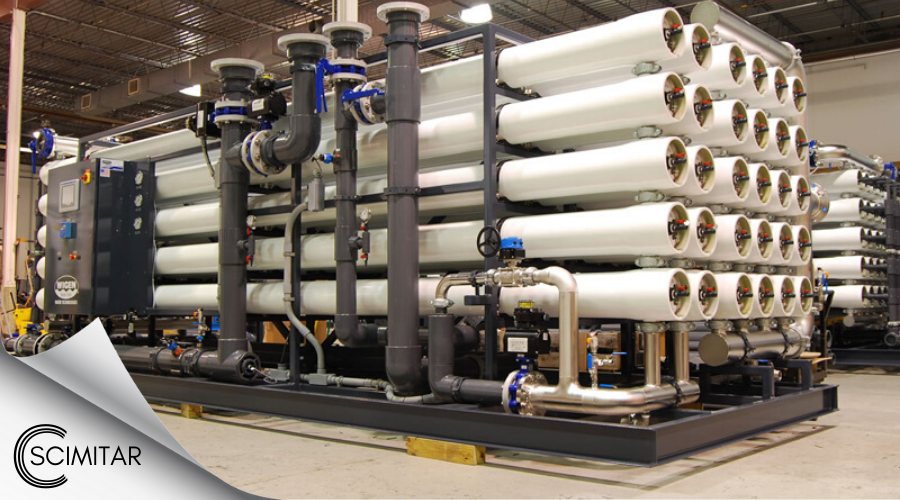Highly efficient, low-energy pressure-driven separation
Nanofiltration (NF) is a membrane liquid-separation technology sharing many characteristics with reverse osmosis (RO). Unlike RO, which has high rejection of virtually all dissolved solutes, NF provides high rejection of multivalent ions, such as calcium, and low rejection of monovalent ions, such as chloride.
What is NF?
Between reverse osmosis and ultrafiltration
Nanofiltration refers to a specialty-membrane process that rejects dissolved solutes in the approximate size range of 1 nanometer (10 Angstroms) — hence the term “nanofiltration.”
With respect to the size and weight of solutes that nanofiltration membranes reject, NF operates in the realm between reverse osmosis (RO) and ultrafiltration (UF): Organic molecules with molecular weights greater than 200 – 400 are rejected. Nanofiltration membranes can effectively reject, among other contaminants:
- Dissolved organics.
- Endotoxins/pyrogens.
- Insecticides/pesticides.
- Herbicides.
- Antibiotics.
- Nitrates.
- Sugars.
- Latex emulsions.
- Metal ions.
It also rejects certain soluble salts. Specifically, NF rejects dissolved salts in the range of 20 – 98 percent. Salts which have monovalent anions (e.g., sodium chloride or calcium chloride) have rejections of 20 – 80 percent, whereas salts with divalent anions (e.g., magnesium sulfate) have higher rejections of 90 – 98 percent. Transmembrane pressures are typically 50 – 225 psi (3.5 – 16 bar).
The ideal nanofiltration membrane has a very high water permeability, but the ideal permeability of solutes might be near zero or some higher value, depending on the solute and application. For example, an application may require near-zero permeability for pesticides and 50 percent permeability for calcium ions.
Typical applications of nanofiltration membrane systems include:
- The removal of color and total organic carbon (TOC) from surface water.
- The removal of hardness or radium from well water.
- The overall reduction of total dissolved solids (TDS).
- The separation of organic from inorganic matter in specialty food* and wastewater applications.
NF Technology Basics
Pressure and crossflow
Like reverse osmosis membranes, nanofiltration membranes are used in separation systems employing applied pressure to effectively overcome the system’s osmotic pressure, reversing the flow of a solvent across a semipermeable membrane from an area of higher solute concentration to an area of lower concentration. This “reversed” flow, and the degree of permeability of the nanofiltration membrane, result in solutes too large to pass through the membrane remaining on the higher-concentration side of the membrane, while purer water that contains desired or acceptable solutes flows through.
Nanofiltration membranes are similar to RO membranes in another way: They are used in crossflow configurations. Crossflow helps to minimize fouling, or the accumulation of solutes that cannot pass through the semipermeable membrane against the membrane. Very simply stated, in crossflow a pressurized flow of feedwater forces lower-concentration water through the NF membrane, while the now-isolated flow of higher-concentration water moves across the surface of the membrane, carrying away the rejected salts and other impurities. The purified water is called the permeate, while the higher-concentration water is called the concentrate or reject.
NF Membrane Performance
Influencing factors
The key performance parameters of a nanofiltration membrane separation process are permeate flux and salt rejection. Under specific reference conditions, flux (the rate of permeate transported per unit of membrane area) and rejection are predictable, intrinsic properties of membrane performance. The flux and rejection of a membrane system are mainly influenced by variable parameters, including:
- Pressure: With increasing effective feed pressure, the permeate TDS will decrease while the permeate flux will increase.
- Temperature: If the temperature increases while all other parameters (pressure, recovery, and feedwater salt concentration) are constant, the permeate flux and the salt passage will increase.
- Recovery: Recovery is the ratio of permeate flow to feed flow. In the case of increasing recovery, the permeate flux will decrease and stop if the salt concentration reaches a value where the osmotic pressure of the concentrate is as high as the applied feed pressure. The salt rejection will decrease with increasing recovery.
- Feedwater salt concentration: With increasing feedwater salt concentration, the permeate flux will decrease while salt passage will increase.
Other factors that may affect the performance of an NF system include:
- Maintenance and operation of the plant.
- Pretreatment design.



